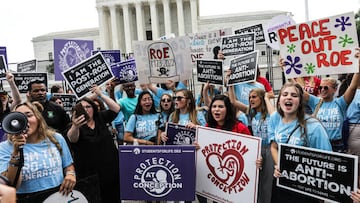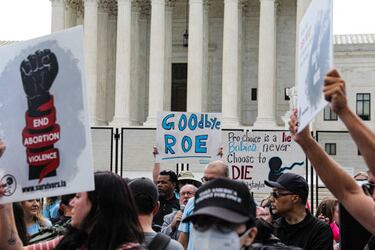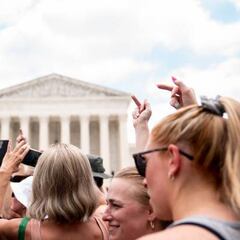What is Roe v Wade in law? What was the 1973 ruling?
The US Supreme Court has overturned the landmark 1973 Roe v Wade ruling, paving the way for states to pass laws banning abortion.

The US Supreme Court on Friday overturned the landmark 1973 Roe v Wade ruling that recognized a woman’s constitutional right to an abortion in the United States and legalized it nationwide, handing a momentous victory to hardline Republicans and religious conservatives who want to limit or ban the procedure.
The court, in a 6-3 ruling powered by its conservative majority, upheld a Republican-backed Mississippi law that bans abortion after 15 weeks. The vote was 5-4 to overturn Roe, with Chief Justice John Roberts writing separately to say he would have upheld the Mississippi law but not taken the additional step of erasing the precedent altogether.
The justices held that the Roe v Wade decision that allowed abortions performed before a fetus would be viable outside the womb - between 24 and 28 weeks of pregnancy - was wrongly decided because the US Constitution makes no specific mention of abortion rights.
A draft version of the ruling written by conservative Justice Samuel Alito indicating the court was likely to overturn Roe was leaked in May, igniting a political firestorm. Friday’s ruling authored by Alito largely tracked his leaked draft.
“The Constitution makes no reference to abortion, and no such right is implicitly protected by any constitutional provision,” Alito wrote in the ruling.
Roe v. Wade recognized that the right to personal privacy under the US Constitution protects a woman’s ability to terminate her pregnancy. The Supreme Court in a 1992 ruling called Planned Parenthood of Southeastern Pennsylvania v Casey reaffirmed abortion rights and prohibited laws imposing an “undue burden” on abortion access.
“Roe was egregiously wrong from the start. Its reasoning was exceptionally weak, and the decision has had damaging consequences. And far from bringing about a national settlement of the abortion issue, Roe and Casey have enflamed debate and deepened division,” Alito added.
By erasing abortion as a constitutional right, the ruling restores the ability of states to pass laws prohibiting it. Twenty-six states are seen as either certain or likely now to ban abortion. Mississippi is among 13 states already with so-called trigger laws designed to ban abortion if Roe v Wade were to be overturned.
The court’s three liberal justices - Stephen Breyer, Sonia Sotomayor and Elena Kagan - issued a jointly authored dissent.
“From the very moment of fertilization, a woman has no rights to speak of”
Supreme Court liberal justices statement
“Whatever the exact scope of the coming laws, one result of today’s decision is certain: the curtailment of women’s rights, and of their status as free and equal citizens,” they wrote.
As a result of Friday’s ruling, “from the very moment of fertilization, a woman has no rights to speak of. A state can force her to bring a pregnancy to term, even at the steepest personal and familial costs,” the liberal justices added.
Abortion rights in the United States had been assured for nearly half a century by the precedent-setting Supreme Court case from 1973, in which a Texas woman challenged the state’s right to outlaw abortion.
Previously states had largely been able to restrict and even remove abortion rights as they liked but the landmark case was the first real constitutional protection offered.

Abortion rights before Roe v Wade
When the United States was founded abortion was legal before ‘quickening’, the point at which a pregnant woman is able to feel the fetus move, which can be around four or five months into the pregnancy.
Abortion was primarily carried out using herbs with the assistance of midwives, and as such the earlier laws which restricted abortions were bans on the substances used in the procedures. By the end of the 19th century most states had introduced some kind of restrictions on abortions, expect when it was needed to save the pregnant woman’s life.
In the first half of the 20th century, anti-abortion groups grew in prominence and their rhetoric was pushed by some who wished to confine women in the traditional childbearing role. The restriction of abortion rights continued in some states until 1970 when Norma McCorvey, under the pseudonym Jane Roe, brought a case against district attorney Henry Wade of Dallas County, Texas,
In Texas the vast majority of abortions were outlawed, with the only exceptions offered in instances where it would save the mother’s life. Roe filed on behalf on her and others to challenge the laws and was joined in her effort by a Texan doctor who had previously been arrested for disobeying the abortion rules.
My thoughts on the Supreme Court's decision to overturn Roe v. Wade. pic.twitter.com/9ALSbapHDY
— Michelle Obama (@MichelleObama) June 24, 2022
Roe v Wade: the landmark abortion case in the United States
The state of Texas maintained that it had the right to safeguard health, draw up medical standards and to protect prenatal life, which it argued was covered by the 14th Amendment. Texas considered a fetus as prenatal life from the point of conception and the notion of what constitutes a ‘person’ would become central to the Supreme Court ruling.
Roe on the other hand claimed her right to “liberty” under the 14th Amendment, and argued the Texas law unconstitutionally impinged on her marital, familial, and sexual privacy. At this stage, it was argued that abortion rights are absolute and that a pregnancy could be ended at any time and for any reason the woman chooses.
Related stories
A key point of the Roe v Wade case was the wording of the Constitution, which says that the protections it affords cover those who are “born or naturalized” in the United States. The Supreme Court therefore decided that “the unborn have never been recognized in the law as persons in the whole sense.”
The court fell short of ruling that women have absolute abortion rights, as Roe had claimed, but dismissed Texas’ assertion that it may overrule the rights of the woman. A framework was drawn up to balance the state’s medical powers with women’s privacy rights, ensuring that a state cannot prohibit abortion within the first two trimesters of pregnancy.

